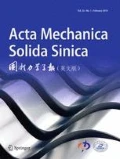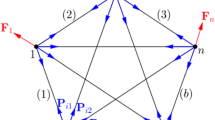Abstract
The purpose of this paper is to investigate the application of topology description function (TDF) in material design. Using TDF to describe the topology of the microstructure, the formulation and the solving technique of the design problem of materials with prescribed mechanical properties are presented. By presenting the TDF as the sum of a series of basis functions determined by parameters, the topology optimization of material microstructure is formulated as a size optimization problem whose design variables are parameters of TDF basis functions and independent of the mesh of the design domain. By this method, high quality topologies for describing the distribution of constituent material in design domain can be obtained and checkerboard problem often met in the variable density method is avoided. Compared with the conventional level set method, the optimization problem can be solved simply by existing optimization techniques without the process to solve the ‘Hamilton-Jacobi-type’ equation by the difference method. The method proposed is illustrated with two 2D examples. One gives the unit cell with positive Poisson’s ratio, the other with negative Poisson’s ratio. The examples show the method based on TDF is effective for material design.
Similar content being viewed by others
References
Eschenauer, H.A. and Olhoff, N., Topology optimization of continuum structures: A review. Applied Mechanics Reviews, Vol.54, No.4, 2001, 331–389.
Larsen, U.D., Sigmund, O. and Bouwstra, S., Design and fabrication of compliant micromechanisms and structures with negative Poisson’s ratio. J Microelectromechanical Systems, Vol.6, No.2, 1997, 99–106.
Bendsoe, M.P. and Kikuchi, N., Generating optimal topologies in structural design using a homogenization method. Computer Methods in Applied Mechanics and Engineering, 1988, Vol.72, 197–224.
Sigmund, O., Design of material structures using topology optimization. In: Olhoff, N. and Rozvany, GIN (eds.): WCSMO-1—First World Congress of Structural and Multidisciplinary Optimization, Oxford/UK: Pergamon Press, 1995.
Sigmund, O. and Torquato, S., Design of materials with extreme thermal expansion using a three-phase topology optimization method. J. Mech. Phys. Solids, Vol.45, No.6, 1997, 1037–1067.
Liu, S.T. and Cao, X.F., Design optimization of material with zero thermal expansion coefficients and design verification with numerically simulated experiments. Acta Materiae Compositae Sinica, Vol.22, No.1, 2005, 126–132 (in Chinese).
Wang, X., Mei, Y. and Wang, M.Y., Level set method for design of multi-phase elastic and thermoelastic materials. Int J of Mechanics and Materials in Design, Vol.1, No.3, 2004, 213–219.
Sigmund, O., Numerical instabilities in topology optimization: a survey on procedure dealing with checkerboards, mesh-dependencies and local Minima. Structural Optimization, Vol.16, No.1, 1998, 68–75.
Bourdin, B., Filters in topology optimization. Int J for Numerical Methods in Engineering, Vol.50, No.9, 2001, 2143–2158.
Luo, Z., Chen, L.P., Zhang, Y.Q. and Huang, Y.Y., Multi-stiffness topological optimization for continuum structures with multiple loading cases and a duplicate sensitivity filtering method. Acta Mechanica Solida Sinica, Vol.26, No.1, 2005, 29–36.
Zhou, M., Shyy, Y.K. and Thmoas, H.L., Checkerboard and minimum member size control in topology optimization. Structural and Multidisciplinary Optimization, Vol.21, No.2, 2001, 152–158.
Stanley, O. and Sethian, J.A., Fronts propagating with curvature-dependent speed: Algorithm based on Hamilton-Jacobi formulations. Journal of Computational Physics, Vol.79, 1988, 12–49.
Guo, X. and Zhao, K., A new topology description function based approach for structural topology optimization. Acta Mechanica Sinica, Vol.36, No.5, 2004, 520–526 (in Chinese).
Ruiter, M.J. de and Keulen, F. van, Topology optimization using a topology description function. Structural and Multidisciplinary Optimization, Vol.26, No.6, 2004, 406–416.
Liu, S.T., Zheng, X.G. and Cheng, G.D., Microstructure design optmization of materials with specific elastic properties. Acta Materiae Compositae Sinica, Vol.18, No.2, 2001, 124–127 (in Chinese).
Author information
Authors and Affiliations
Corresponding author
Additional information
Project supported by the National Natural Science Foundation of China (No.10332010), the Innovative Research Team Program (No.10421202), the National Basic Research Program of China (No. 2006CB601205) and the Program for New Century Excellent Talents in Universities of China (2004).
Rights and permissions
About this article
Cite this article
Cao, X., Liu, S. Topology description function based method for material design. Acta Mech. Solida Sin. 19, 95–102 (2006). https://doi.org/10.1007/s10338-006-0611-y
Received:
Revised:
Published:
Issue Date:
DOI: https://doi.org/10.1007/s10338-006-0611-y




